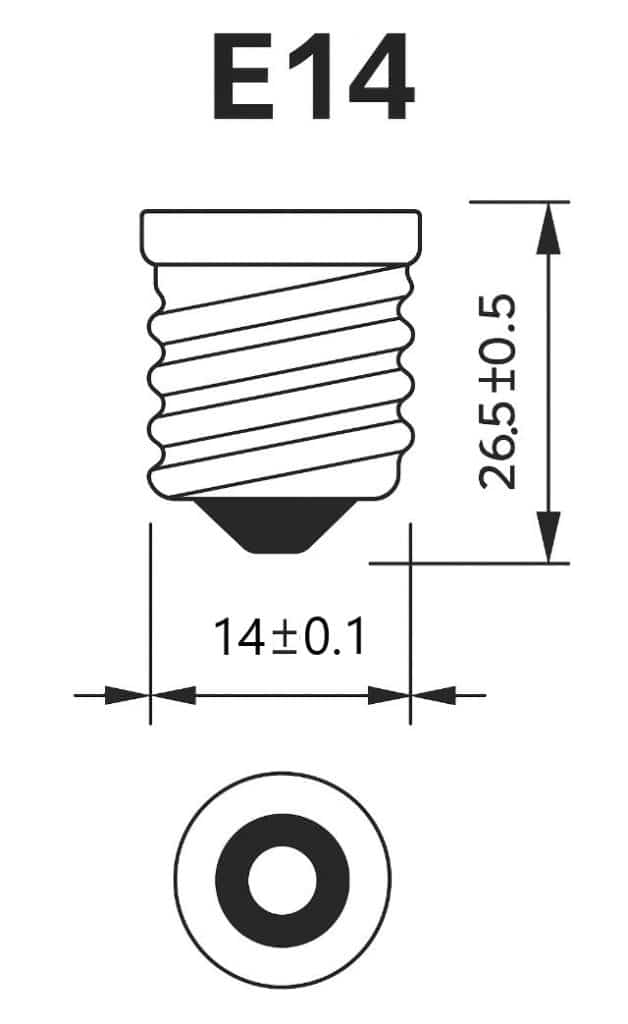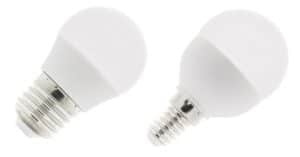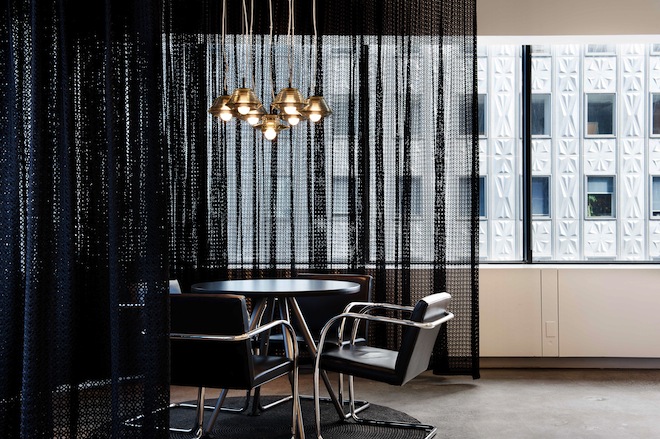Have you ever noticed those bulbs that fit perfectly in wall lights, small ceiling lamps or even chandeliers? Well, most likely, they were equipped with an E14 socket. This is a format that combines versatility with compact design.
What is an E14 socket?
The E14 socket is one of the most widely used in the world of domestic lighting. Its name comes from the surname of Thomas Edison, the inventor of the threaded socket, and the diameter of the socket: 14 millimeters. This thin, narrow thread is ideal for small or decorative lamps, making it a popular solution in both residential and commercial settings.
This is one of the most common socket types in Europe and other countries with compatible thread systems.

Main characteristics of the E14 socket
When talking about the E14 socket, it is essential to understand what its main technical and functional characteristics are. Here is a detailed breakdown:
- Diameter: 14 mm.
- Type of thread: Small Edison thread.
- Voltage: Generally 220V – 240V.
- Maximum power: Varies according to the bulb, although E14 LED bulbs usually have a much lower power consumption compared to traditional bulbs.
- Common materials: Metal in the base, ceramic or heat resistant plastic in the body of the socket.
- Compatibility: Fits a wide range of luminaires, from decorative lamps to household appliances.
A key advantage of the E14 socket is its ability to provide precise illumination in small spaces where a larger socket would simply not fit. Its compact design does not sacrifice power, especially if you opt for LED bulbs, which are much more efficient and long-lasting.
Moreover, today you can find bulbs with E14 socket in different styles: from standard bulbs, through decorative vintage filament models, to more modern solutions such as multicolor RGB bulbs that allow you to change the ambiance with just one click.
If you are thinking of renewing the lighting of your home or business, you can take a look at our catalog of E14 LED bulbs, where you will find multiple options for every need.
What is the difference between E14 and E27?
The main difference between the E14 and E27 socket lies in their size. While the E14 has a diameter of 14 mm, the E27 has 27 mm. This makes the E27 more suitable for larger and higher wattage bulbs, commonly used in ceiling lamps, soffits or main light fixtures.

Other key differences:
- Compatibility: E27 is more universal, but E14 is perfect for tight spaces and designer lamps.
- Appearance: E14 is more streamlined and blends in better with decorative or classic luminaires.
- Application: E14 is used in environments where aesthetics and warmth are sought, while E27 is geared more towards general lighting.
What types of bulbs use E14 socket?
The E14 socket is so versatile that it is used for various types of bulbs, both traditional and modern. Here is an overview of the main types:
- Smart bulbs: Yes, there are also smart models with E14 socket that you can control via WiFi or Bluetooth from your mobile or voice assistant. These are ideal for those looking for convenience and total lighting customization.
- LED filament bulbs: With a retro design, they mimic the aesthetics of old incandescent bulbs, but with the efficiency of LED technology.
- E14 RGB bulbs: Perfect for creating customized environments, these bulbs allow you to change color and intensity, and are widely used in youth rooms or creative spaces.
In our store you can find a wide variety of E14 models organized by category: standard bulbs, filament bulbs or RGB bulbs, all designed to suit your needs.
Productos recomendados
Ver Productos
Ver Productos
Ver Productos
Ver Productos
Most common uses of E14 bulbs.
The E14 socket bulb is present in many, many spaces in the home and professional environment. Due to its compact size and ease of installation, it has become a preferred choice for the following uses:
- Table lamps and bedside tables: its small size makes it ideal for compact luminaires that do not support large bulbs.
- Chandeliers and decorative hanging lamps: In these cases, candle bulbs with E14 sockets are the most popular choice.
- Appliances: Some ovens, refrigerators and extractor hoods use bulbs with this type of socket.
- Bathroom and vanity lighting: The softer, more diffused lights needed for these areas usually come in E14 format.
- Ambient or accent lighting: Perfect for creating warm points of light in specific areas of the home, such as shelves, pictures or display cases.
In addition, it is common to find E14 bulbs in commercial or hospitality installations where decorative and discreet lighting is sought.
Advantages of using bulbs with E14 sockets
Choosing bulbs with E14 socket is not only a question of compatibility with the luminaire, but also a smart decision if you are looking for efficiency, style and functionality. This type of bulb offers multiple benefits that go far beyond its small size. Here are some of the most important advantages:
1. Energy savings
Thanks to the evolution of LED technology, E14 bulbs are no longer a decorative luxury but an efficient alternative. An E14 LED bulb can consume up to 90% less energy than an equivalent incandescent bulb, which translates into lower energy bills without sacrificing light quality.
2. Long service life
An LED bulb with an E14 socket can last between 15,000 and 25,000 hours, much longer than any incandescent or halogen bulb. This means that, in addition to saving on consumption, you forget about changing bulbs for years.
3. Aesthetic versatility
This socket is available in a wide variety of shapes and styles. You can choose from classic candle designs, vintage-style filament bulbs, or even smart models with RGB functionality. This allows you to match the bulb not only to your lamp, but also to the decorative style of the space.
4. Compact size, high performance
One of the biggest advantages of the E14 is its small size, which makes it perfect for small luminaires or specific designs, without sacrificing brightness. Even in limited spaces, you can enjoy powerful, well-distributed illumination.
5. Easy installation and replacement
E14 bulbs use a very simple threading system. All you need to do is twist and snap in, no tools or complicated installation. This makes them a quick and practical solution for anyone.
If you are thinking of renewing your bulbs, do not hesitate to visit our E14 LED bulbs category where you can find high quality and excellent efficiency options.

Tips for choosing the right E14 bulb
Choosing the right bulb may seem like a no-brainer, but there are several factors to consider to ensure it meets your specific needs. Here’s a quick and handy guide to make sure you don’t make a mistake when buying an E14 bulb:
Define the function of the space 2.
Are you looking for decorative, ambient or functional light? For example:
- To create ambiance in the bedroom, choose a warm bulb (2700K).
- For desk or reading areas, opt for cool light (6000K or more).
- For decorative uses such as pendant lamps or chandeliers, consider E14 filament bulbs that combine style with efficiency.
2. Choose the shape and style of the bulb.
E14 bulbs come in various shapes:
- Candle type: ideal for hanging lamps or chandeliers.
- Globe type: Perfect for table lamps or bedside tables.
- Tubular: Very common in household appliances such as refrigerators or extractor hoods.
You can also use special bulbs such as multicolor RGB if you want to customize the environment in a creative way.
3. Check the wattage and equivalence
If you are looking for powerful lighting without high consumption, choose LED bulbs between 4W and 7W, which offer an equivalence to traditional bulbs of 40W to 60W. Not only will you save energy, you will also maintain excellent light quality.
4. Dimmer compatibility
Does your lamp have a dimmer? Then make sure you buy a dimmable bulb. Not all E14 LED bulbs are, so always check the product specifications.
5. Energy efficiency and labeling
Look for bulbs with an A+ energy label or higher. This guarantees low consumption, good intensity and durability. In our online store you will find a specific section of E14 bulbs by type for you to choose with all the information at hand.
Conclusion
The E14 socket is much more than just a small thread: it is an efficient, versatile and decorative lighting solution. From table lamps to elegant chandeliers, from household appliances to designer luminaires, its adaptability makes it one of the most popular formats in Europe.
Thanks to LED technology, E14 bulbs offer not only aesthetics, but also performance, energy savings and durability. Whether you’re looking for a classic bulb, a vintage filament option or a modern RGB, you’ll find a perfect alternative for every corner of your home.